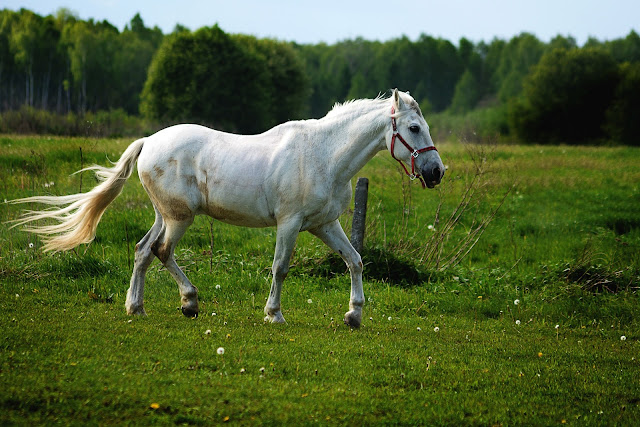For my second reading this week I chose the Mabinogi or the Mabinogion. I chose it because the description sounded interesting and the stories didn't seem to be any that I knew. I didn't realize that all of the first part of the unit was about the same character, but I am glad that it was. I haven't read many stories this year that are that continuous so I found it refreshing. I chose the picture above because this is what I imagined the horse that Arawn was ridding when he entered the clearing. Because this is such a long story, I would likely only write a story based on a portion of it. Because of this I chose to take notes over "Pwyll Goes Hunting" and "In the Stead of Arawn." Here are the notes I took while I was reading:
- Pwyll, Prince of Dyved, Lord of the Seven Cantrevs of Dyved
- Pwyll wanted to go hunting and chose to do so in Glyn Cuch
- He got to Glyn Cuch let his dogs go and started after them
- He hears other dogs barking that aren’t his dogs and they are coming from the opposite direction
- When they get to the edge of a clearing Pwyll can see the other dog chasing down a stag
- The dogs are white with red ears and red eyes
- He drove off the other dogs to let his dogs at the stag
- While he is doing this he sees a horseman coming
- The horse is light grey and the rider is in grey woolen hunting gear
- The rider is annoyed at Pwyll and refuses to great him
- Pwyll asks why the man will not great him
- The rider says because of Pwyll’s ignorance and lack of courtesy
- Pwyll doesn’t understand how he has been discourteous
- The rider points out that driving away the dogs that brought down the stag to let his own dogs have it is discourteous, and therefore the rider will do Pwyll dishonor
- Pwyll wants to know how he can fix this, how he can make amends and become the rider’s friend
- This is when Pwyll finds out the the rider is Arawn King of Annwyn
- Arawn tells Pwyll that to gain his friendship he should trade places with him in his court and a year later when Arawn is set to fight another king, Arawn should strike him down but not deliver a final blow
- Pwyll agrees, and Arawn makes Pwyll look just like him, and himself look just like Pwyll
- They go to each other’s kingdoms and rule for a year
- When it is time for Pwyll to go fight Arawn’s enemy, he does as he was told: he strikes him down but doesn’t kill him
- After the men following the fallen man pledge allegiance to Pwyll
- Then Pwyll’s nobles say he should be the lord of all and so he conquered the country
- He then when to meet Arawn at the appointed time and place and both were restored to their proper forms
Bibliography
The Mabinogion by Lady Charlotte Guest
Photo Credit
The Horse by Katrina_S via Pixabay

Comments
Post a Comment